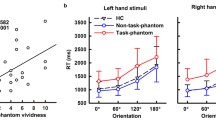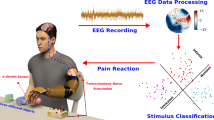Abstract
Pain catastrophizing has been associated with phantom limb pain, but so far the cortical processes and the brain regions involved in this relationship have not been investigated. It was therefore tested whether catastrophizing was related to (1) spontaneous pain, (2) somatosensory activity and (3) cortical responses in phantom limb pain patients. The cortical responses were investigated via electroencephalography (EEG) as it has a high temporal resolution which may be ideal for investigating especially the attentional and hypervigilance aspect of catastrophizing to standardized acute stimuli. Eighteen upper limb amputees completed the pain catastrophizing scale. Patients’ spontaneous pain levels (worst and average pain, numerical rating scales) and thresholds to electrical stimulation (sensory detection and VRS2: intense but not painful) were determined. Non-painful electrical stimuli were applied to both the affected and non-affected arm, while high-resolution (128 channels) EEG signals were recorded. Catastrophizing accounted for significant amounts of the variance in relation to spontaneous pain, especially worst pain (64.1%), and it was significantly associated with thresholds. At the affected side, catastrophizing was significantly related to the power RMS of the N/P135 dipole located in the area around the secondary somatosensory cortex which has been shown to be associated with arousal and expectations. These findings corroborate the attentional model of pain catastrophizing by indicating that even non-painful stimuli are related to enhanced attention to and negative expectations of stimuli, and they suggest that memory processes may be central to understanding the link between catastrophizing and pain.


Similar content being viewed by others
References
Bromm B (2004) The involvement of the posterior cingulate gyrus in phasic pain processing of humans. Neurosci Lett 361:245–249. doi:10.1016/j.neulet.2004.01.018
Buchgreitz L, Egsgaard LL, Jensen R, Arendt-Nielsen L, Bendtsen L (2008) Abnormal pain processing in chronic tension-type headache: a high-density EEG brain mapping study. Brain 131:3232–3238. doi:10.1093/brain/awn199
Egsgaard LL, Buchgreitz L, Wang L, Bendtsen L, Jensen R, Arendt-Nielsen L (2012) Short term cortical plasticity induced by conditioning pain modulation. Exp Brain Res 216:91–101. doi:10.1007/s00221-011-2913-7
Flor H (2008) Maladaptive plasticity, memory for pain and phantom limb pain: review and suggestions for new therapies. Expert Rev Neuother 8:809–818
Flor H, Birbaumer N (2000) Phantom limb pain: cortical plasticity and novel therapeutic approaches. Curr Opin Anaesthesiol 13:561–564
Flor H, Elbert T, Knecht S, Wienbruch C, Pantev C, Birbaumer N, Larbig W, Taub E (1995) Phantom-limb pain as a perceptual correlate of cortical reorganization following arm amputation. Nature 375:482–484. doi:10.1038/375482a0
Flor H, Elbert T, Muhlnickel W, Pantev C, Wienbruch C, Taub E (1998) Cortical reorganization and phantom phenomena in congenital and traumatic upper-extremity amputees. Exp Brain Res 119:205–212. doi:10.1586/14737175.8.5809
Flor H, Nikolajsen L, Staehelin Jensen T (2006) Phantom limb pain: a case of maladaptive CNS plasticity? Nat Rev Neurosci 7:873–881. doi:10.1038/nrn1991
Frot M, Rambaud L, Guenot M, Mauguiere F (1999) Intracortical recordings of early pain-related CO2-laser evoked potentials in the human second somatosensory (SII) area. Clin Neurophysiol 110:133–145
Frot M, Garcia-Larrea L, Guenot M, Mauguiere F (2001) Responses of the supra-sylvian (SII) cortex in humans to painful and innocuous stimuli. A study using intra-cerebral recordings. Pain 94:65–73
Gracely RH, Geisser ME, Giesecke T, Grant MA, Petzke F, Williams DA, Clauw DJ (2004) Pain catastrophizing and neural responses to pain among persons with fibromyalgia. Brain 127:835–843. doi:10.1093/brain/awh098
Gratkowski M, Haueisen J, Arendt-Nielsen L, Chen AC, Zanow F (2006) Time-frequency filtering of MEG signals with matching pursuit. J Physiol Paris 99:47–57. doi:10.1016/j.jphysparis.2005.06.009
Gratkowski M, Haueisen J, Arendt-Nielsen L, Chen AC, Zanow F (2008) Decomposition of biomedical signals in spatial and time-frequency modes. Methods Inf Med 47:26–37
Hanley MA, Jensen MP, Ehde DM, Hoffman AJ, Patterson DR, Robinson LR (2004) Psychosocial predictors of long-term adjustment to lower-limb amputation and phantom limb pain. Disabil Rehabil 26:882–893
Hill A, Niven CA, Knussen C (1995) The role of coping in adjustment to phantom limb pain. Pain 62:79–86. http://www.brainvoyager.com/BrainTutor.html
Jensen MP, Ehde DM, Hoffman AJ, Patterson DR, Czerniecki JM, Robinson LR (2002) Cognitions, coping and social environment predict adjustment to phantom limb pain. Pain 95:133–142
Lancaster JL, Woldorff MG, Parsons LM, Liotti M, Freitas CS, Rainey L, Kochunov PV, Nickerson D, Mikiten SA, Fox PT (2000) Automated Talairach atlas labels for functional brain mapping. Hum Brain Mapp 10:120–131
Lefebvre JC, Keefe FJ (2002) Memory for pain: the relationship of pain catastrophizing to the recall of daily rheumatoid arthritis pain. Clin J Pain 18:56–63
Linden DE (2005) The p300: where in the brain is it produced and what does it tell us? Neuroscientist 11:563–576. doi:10.1177/1073858405280524
Lopes da Silva FH, Wieringa HJ, Peters MJ (1991) Source localization of EEG versus MEG: empirical comparison using visually evoked responses and theoretical considerations. Brain Topogr 4:133–142
Mallat SG, Zhang Z (1993) Matching pursuits with time-frequency dictionaries. IEEE Trans Signal Process 41:3397–3415
Mersky H, Bogduk N (eds) (1994/2007) Classification on chronic pain, second ed. IASP task force on taxonomy. Part III: pain terms, a current list with definitions and notes on usage. IASP Press, Seattle
Michel CM, Murray MM, Lantz G, Gonzalez S, Spinelli L, Grave de Peralta R (2004) EEG source imaging. Clin Neurophysiol 115:2195–2222
Niddam DM, Yeh TC, Wu YT, Lee PL, Ho LT, Arendt-Nielsen L, Chen AC, Hsieh JC (2002) Event-related functional MRI study on central representation of acute muscle pain induced by electrical stimulation. Neuroimage 17:1437–1450
Nikolajsen L, Jensen TS (2001) Phantom limb pain. Br J Anaesth 87:107–116
Oostenveld R, Praamstra P (2001) The five n electrode system for high-resolution EEG and ERP measurements. Clin Neurophysiol 112:713–719
Price DD (1999) Psychological mechanisms of pain and analgesia. Progress in pain research and management. IAPS Press, Seattle
Price DD, Milling LS, Kirsch I, Duff A, Montgomery GH, Nicholls SS (1999) An analysis of factors that contribute to the magnitude of placebo analgesia in an experimental paradigm. Pain 83:147–156. doi:10.1016/s0304-3959(99)00081-0
Pritchard WS (1981) Psychophysiology of P300. Psychol Bull 89:506–540. doi:10.1037/0033-2909.89.3.506
Quartana PJ, Campbell CM, Edwards RR (2009) Pain catastrophizing: a critical review. Expert Rev Neurother 9:745–758
Richardson C, Glenn S, Horgan M, Nurmikko T (2007) A prospective study of factors associated with the presence of phantom limb pain six months after major lower limb amputation in patients with peripheral vascular disease. J Pain 8:793–801. doi:10.1016/j.jpain.2007.05.007
Rosenstiel AK, Keefe FJ (1983) The use of coping strategies in chronic low back pain patients: relationship to patient characteristics and current adjustment. Pain 17:33–44
Sawamoto N, Honda M, Okada T, Hanakawa T, Kanda M, Fukuyama H, Konishi J, Shibasaki H (2000) Expectation of pain enhances responses to nonpainful somatosensory stimulation in the anterior cingulate cortex and parietal operculum/posterior insula: an event-related functional magnetic resonance imaging study. J Neurosci 20:7438–7445
Seminowicz DA, Davis KD (2006) Cortical responses to pain in healthy individuals depends on pain catastrophizing. Pain 120:297–306. doi:10.1016/j.pain.2005.11.008
Sullivan MJL, Bishop SR, Pivik J (1995) The pain catastrophizing scale: development and validation. Psychol Assess 7:524–532. doi:10.1037/1040-3590.7.4.524
Sullivan MJ, Thorn B, Haythornthwaite JA, Keefe F, Martin M, Bradley LA, Lefebvre JC (2001) Theoretical perspectives on the relation between catastrophizing and pain. Clin J Pain 17:52–64
Treede RD, Apkarian AV, Bromm B, Greenspan JD, Lenz FA (2000) Cortical representation of pain: functional characterization of nociceptive areas near the lateral sulcus. Pain 87:113–119
Van Damme S, Crombez G, Eccleston C (2002) Retarded disengagement from pain: the role of catastrophic thinking about pain. Pain 100:11–18
Van Damme S, Crombez G, Eccleston C (2004) Disengagement from pain cues: the effects of pain catastrophizing and pain expectancy. Pain 107:70–76
Vase L, Nikolajsen L, Christensen B, Egsgaard LL, Arendt-Nielsen L, Svensson P, Jensen TS (2011) Cognitive-emotional sensitization contributes to wind-up-like pain in phantom limb pain patients. Pain 152:157–162. doi:10.1016/j.pain.2010.10.013
Vecchiet L, Galletti R, Giamberardino MA, Dragani L, Marini F (1988) Modifications of cutaneous, subcutaneous, and muscular sensory and pain thresholds after the induction of an experimental algogenic focus in the skeletal muscle. Clin J Pain 4:55–60
Whyte A, Carroll LJ (2004) The relationship between catastrophizing and disability in amputees experiencing phantom pain. Disabil Rehabil 26:649–654. doi:10.1080/09638280410001672508
Acknowledgments
This study was supported by the MINDLab UNIK initiative at Aarhus University which is funded by the Danish Ministry of Science, Technology and Innovation. The study was also partially funded by a grant from the Lundbeck Foundation No R17-A1679. The authors would like to thank Helle O. Andersen for technical assistance.
Author information
Authors and Affiliations
Corresponding author
Additional information
Lene Vase and Line Lindhardt Egsgaard have contributed equally to the paper.
Rights and permissions
About this article
Cite this article
Vase, L., Egsgaard, L.L., Nikolajsen, L. et al. Pain catastrophizing and cortical responses in amputees with varying levels of phantom limb pain: a high-density EEG brain-mapping study. Exp Brain Res 218, 407–417 (2012). https://doi.org/10.1007/s00221-012-3027-6
Received:
Accepted:
Published:
Issue Date:
DOI: https://doi.org/10.1007/s00221-012-3027-6




